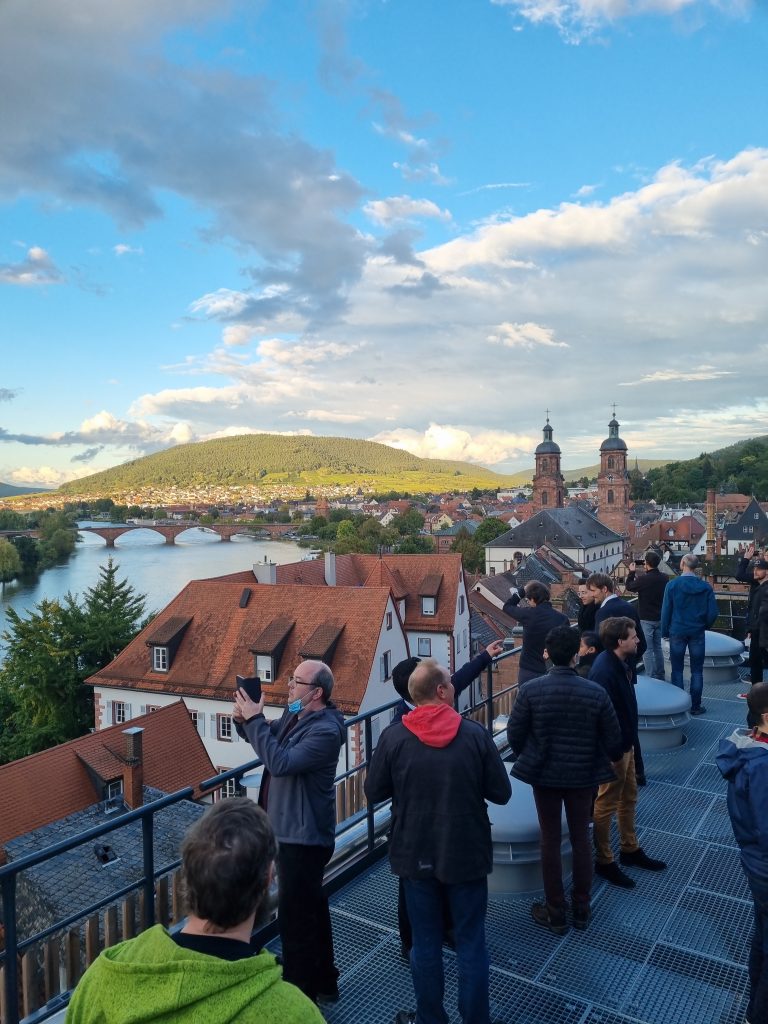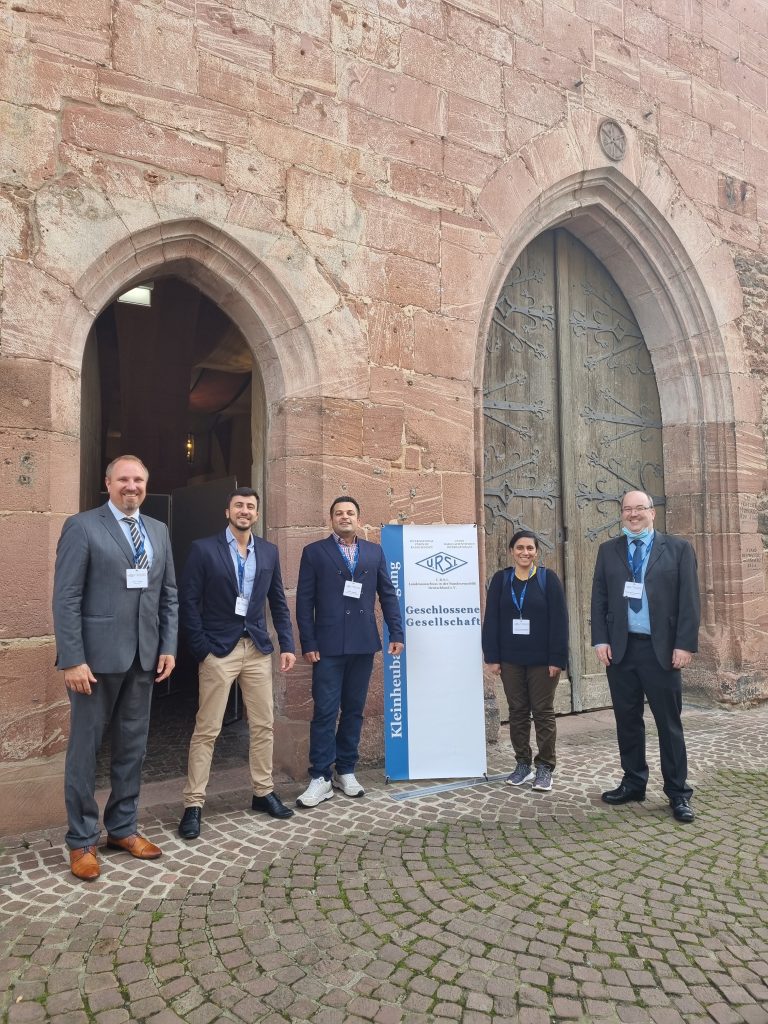This blog reports on the experience at the ”Kleinheubacher Tagung 2021”, which was the first face-to-face conference of the Germany-based ESRs.
In August 2020 I flew from Sao Paulo to Germany to start my PhD. Due to the circumstances of the pandemic and consequently also the flooding disaster of July 2021, which heavily affected my workplace, I had to adapt to a new work style. This work routine relied on less face-to-face social contact, more MS Teams meetings, as well as all training and conference participations conducted on online platforms.
Fortunately, as a result of the vaccination ramp-up in Germany and the declining numbers of COVID-19 infections, larger-scale events became possible again in the early summer of 2021. Therefore, I had the opportunity to experience my first face-to-face dissemination event together with my fellow ESRs Samikshya (ESR1) and Arash (ESR2). This event was the ‘’Kleinheubacher Tagung 2021’’, which is a conference held in the German city of Miltenberg annually. It is intended for scientists with different backgrounds in the fields of EMC, telecommunications and signal processing to present their research results and engage in discussions.

Fig. 1 – Kleinheubacher Tagung 2021.

Fig. 2 – Main street in the old town of Miltenberg.

Fig. 3 – Part of the Miltenberg Old Town (that reminds scenes from Disney films).
The Kleinheubacher Tagung 2021 took place on the 26th, 27th and 28th of September in the old town hall of Miltenberg. The accepted contributions to the event were divided into oral and poster presentations. On this occasion, a special session dedicated to PETER project was organised by our supervisors from WIS Munster – Martin Schaarschmidt and Sven Fisahn.
Under the title ” Introduction to Special Session on Risk Analysis and German activities within MSCA ITN “PETER – Pan-European Training, Research & Education Network on Electromagnetic Risk Management “, the special session was held on the first day of the event and was divided into two parts. First, the objectives and activities of the PETER project were outlined by Sven Fisahn. Then, the activities of PETER project developed within Germany were presented by the ESRs with the following oral presentations:
- Arash Nateghi (ESR2) – Electromagnetic Interferences on Smart-Grid Communication and Related EMI Risk Management;
- Fernando Arduini (ESR15) – Vulnerability of smart grid-enabled protective relays to IEMI;
- Samikshya Ghosalkar (ESR1) – Bayesian Network Analysis for Critical Infrastructure systems in the context of IEMI including non- technical aspects.
At the end of each presentation a Q&A session was held, in which the ESRs could discuss with the audience about their respective works. In these parts, discussions and exchange of information with several professionals of the field took place.

Fig. 4 – Our special session taking place in the conference room of the old town hall of Miltenberg.

Fig. 5 – Our squad enjoying the view from a castle in Miltenberg.
Apart from the scientific gain, the most rewarding part was meeting my colleagues and supervisors of the PETER project in a more informal way. I believe that opportunities like these are important for us to share our ideas and impressions in a more relaxed manner, as well as further strengthen our synergy as a team. The social activities organised by the conference committee included walking tours around the picturesque Miltenberg and a visit to a local brewery, where a beer tasting was offered at the end of the tour.

Fig. 6 – Conference attendees enjoying the views from the rooftop of the local brewery.

Fig. 7 – Beer tasting with Bretzels to accompany the experience at the local brewery.

Fig. 8 – The little squirrels given away at the event as vouchers for coffees and desserts at a local coffee shop were one of the entertaining points among us.
(If you get my point, everyone was looking for new squirrels, lol)

Fig. 9 – Another distinguished guest, Samikshya (ESR1), at one of the oldest continuously operating hotels in the world: Zum Riesen Hotel.
Personally speaking, I found the experience of disseminating and discussing in person the outcomes of my months of dedication very rewarding. Allied to this, my desire to attend events like this over the next months has only been reinforced. It seems obvious to say it, but the participation in the Kleinheubacher Tagung 2021 after months of isolation was like a light at the end of the tunnel for a new chapter that I hope will come true from now on. A chapter that will be full of opportunities to disseminate my work as well as to network with different people.

Fig. 10 – Part of our PETER team from Germany.
About the Author: Fernando R. Arduini
 Fernando R. Arduini holds a B.Sc. in Electrical Engineering from the Federal University of Triângulo Mineiro in Brazil. He completed part of his studies at the University of Glasgow in the United Kingdom, where he also performed an internship on wind energy integration into the power grid. In 2019 and 2020, respectively, he accomplished his M.Sc. degree in Power Systems and MBA in Business Management with Distinction, both from the University of São Paulo in Brazil. His Master’s thesis was focused on emerging hardware and software Fault Ride-Through strategies applied to DFIG-based wind turbines. In 2019, Fernando worked at CITCEA-Barcelona Tech, Spain, on the modelling and integration of Superconducting Fault Current Limiters applied to smart grids applications.
Fernando R. Arduini holds a B.Sc. in Electrical Engineering from the Federal University of Triângulo Mineiro in Brazil. He completed part of his studies at the University of Glasgow in the United Kingdom, where he also performed an internship on wind energy integration into the power grid. In 2019 and 2020, respectively, he accomplished his M.Sc. degree in Power Systems and MBA in Business Management with Distinction, both from the University of São Paulo in Brazil. His Master’s thesis was focused on emerging hardware and software Fault Ride-Through strategies applied to DFIG-based wind turbines. In 2019, Fernando worked at CITCEA-Barcelona Tech, Spain, on the modelling and integration of Superconducting Fault Current Limiters applied to smart grids applications.


